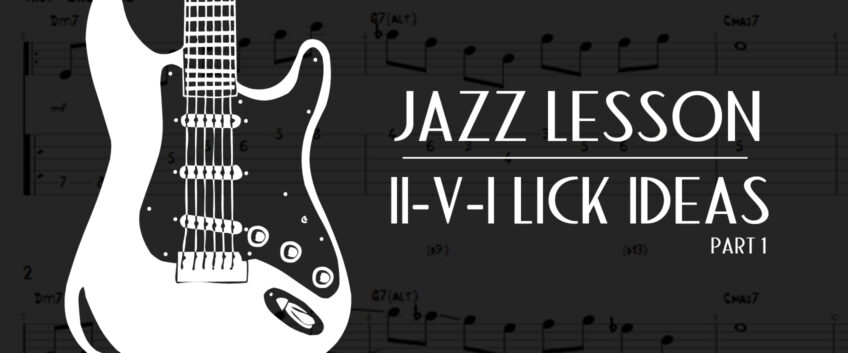
Guitar Lesson: Jazz Licks in II-V-I (part. 1)
In jazz music, and particularly in “Be-Bop”, there is a harmonic cadence called the “II-V-I”. This is by far the most widely used cadence. It is found in virtually all standards. But what is a II-V-I?
This article was submitted by Andry Ravaloson, artistic advisor at Arobas Music.
They are just degrees in Roman numerals of the major scale harmonisation (intervals of thirds).
The II-V-I cadence in the case of C major is:
If we play the C major scale on this cadence, no note will be wrong.
Conversely, the licks that we play will seem bland or boring.
It is the “dissonance” or perceived friction that gives the jazzy licks their character. But where does it come from?
Well, it comes from the fact that Jazz musicians change the “V”. This means that on a “V7” chord, in our case, G 7(alt), only the essentials are kept: the tonic (G), third (B) and seventh (F). The other notes: ninth, fifth, sixth (or thirteenth) are played a semi-tone above (#) or below (b) depending on the tension they want to create.
I will show you some ways of changing the “V7” to create tension but also to choose a distinctive note for the final C maj7 chord. I arbitrarily chose the third (E) for the final note because I think it best characterises the chord. However, we can of course choose any note from the chord.
 “Jazz Guitar Licks – II-V-I (n°1).gpx”
“Jazz Guitar Licks – II-V-I (n°1).gpx”
(click on the image to download the tablature)
These three licks are obviously only examples. I deliberately have the same lick for the II, and also the same resolution (third) for the I. Feel free to experiment with this exercise because it’s easier to remember something you discover by yourself but also it’s more satisfying.
Good luck!
About the author
Andry started learning the music on his own at age 9-10, then animating weddings, dancing nights (Rock, Latino music, Waltz…) until the age of 17. As soon as he arrived in France in 1979, he turned to Jazz and improvisational music, and became a professional musician.
Andry also collaborated with a great many Jazz bands (Passages, ORJ Nord-Pas-de-Calais, Collectif Ondes Parallèles) and got credited on 11 studio albums throughout his career.
He has taught several years at the Valenciennes CMA school (Campus des Musiques Actuelles) and at the Lille Conservatoire. He currently holds a position of artistic advisor with Arobas Music.
Leave a comment
Your email address will not be published.
| Title | Artist | |
|---|---|---|
| La Bamba | Los Lobos | |
Poison

|
Alice Cooper | |
| The Chair | George Strait | |
| Always Remember Us This Way | Lady Gaga | |
American Jesus

|
Bad Religion |






3 Comments
Hi Andry, if I am using Guitar Pro 7.5 and am using the Line In with a Presonus Audio Box audio interface, can I use my guitar as an input device?
Sorry for this newbe question, but I cannot find out how to enter maj7 chords like the Cmaj7 on your sheet. Could you pls give me a hint?
Hello Arne, to enter chords names and diagrams in your tab please select a note in your tab and click on the right button of the mouse and select “Note” and “Chord”. You will be able to write the name of the chord and also add a chord diagram if you want.
Click on the section “File” and “Stylesheet” to select the way you want to display your diagrams:
– Diagram list at the beginning of the score
– Diagrams in the score
You can also select the functionality in the Edition panel or use the keyboard shortcut “Shift + A”.